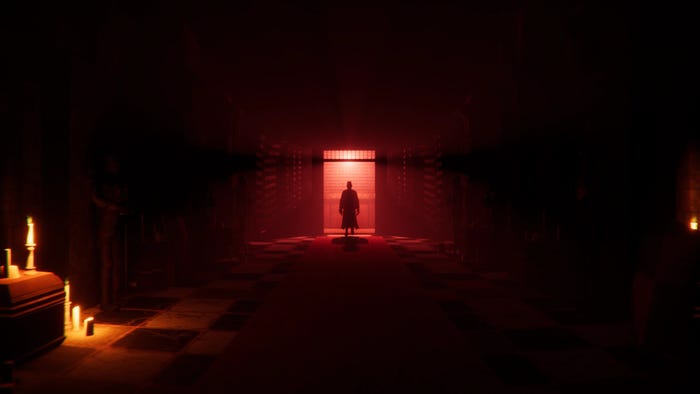
Featured Blog | This community-written post highlights the best of what the game industry has to offer. Read more like it on the Game Developer Blogs.
Showcasing your game is always an adventure, even more so if you're an indie dev. Here are 7 tips we wish we knew when we started showcasing our games.

This article was originally published on Bedtime Digital Games' devblog.
Hello everyone!
Following our feedback video about EGX Rezzed where we showcased Figment, we thought it would be interesting to talk a bit more about events. They are an important part of game marketing, even for indie developers, as you can directly interact with consumers and raise awareness around your game. Showcasing also often goes hand in hand with awards, and who doesn’t like awards?
 Back to Bed at Gamescom 2014. What a throw back.
Back to Bed at Gamescom 2014. What a throw back.
We’ve been going to events for few years now, first to showcase Back to Bed, then Figment. We were green and naive at first, but we’ve learned a few things along the way that we think are worth sharing (or at least, some things we wish we had known right from the start). So, lo and behold, our tips and tricks to showcase your game.
1. Journalists won’t come to you. Go to them first.
Journalists are busy people, constantly courted left and right. With all the competition out there, even if you were lucky enough to get your game covered in a big gaming outlet, chances are most journalists still haven’t heard about your game. At events, they will probably be too busy to look at your game, even if it is awesome, and you’ll probably be busy too showcasing the game to the public anyway. Chance encounters can happen, but don’t leave your game’s visibility to chance.
Reach out to journalists before the event. Let them know about your game (with a pitch, some screenshots and even a build) and invite them to meet for a talk about it. Depending on your availabilities, you can set up a meeting before, during or after the event, at your booth or another location.
Where to get journalists’ emails then, and how can you know who is going to come? Event organisers often provide press lists to exhibitors, including names and email addresses. You can also scout social media like Twitter to see which influencers plan to go to the event you’re going to, or browse the internet and see which outlets attended the event the previous years.
2. Keep in touch with your players.
At an event, a lot of people are going to see your game. They may love it, shower you with praise and wish you the best, but they’ll also see a lot of other cool games at that event. They may forget about yours in the process.
An easy way to refresh their memories is to send them an email after the event, but first you need to get said email. Make it simple: if someone is interested in your game, don’t be shy and just ask them if they want to give you their email address. If they genuinely liked your game, they’ll be happy to hear back from you (and it is also a good time to include the address of your game’s awesome website or steam page).
At Bedtime, we use tablets to store players’ email addresses, but pen and paper can be as efficient.
3. People like physical stuff, so give them physical stuff to like.
Another way to keep your players’ memory fresh is to not only get their email address to contact them later on, but give them a physical item. This will make them remember you when they empty their bags at the end of the day, and make it easier for them to talk about your game to other people.
Physical items of various kind work: badges, stickers, flyers… We use the later at Bedtime. We put some nice artwork of our game on one side (so people can display it if they want), and ways to reach us on the other (so they know how to get back to you). Here’s an extra tip for flyers: use the least amount of text possible on them, so you don’t have to worry about translating them if you showcase your game abroad.
 Plus, physical items can help decorate your booth!
Plus, physical items can help decorate your booth!
4. Tailor your prototype to the event you’re going to.
Games are usually built around an experience at home, either in a couch or in front of a computer. Events don’t really have the same mood or atmosphere, to say the least. Players, even with all their good will, won’t probably have the time or focus to play your full game. You are also going to an event for a specific reason: to raise awareness around your game, test a specific mechanic… There’s often no point in offering the full, raw experience of your game.
Pick out what you want to showcase the most, and make a build accordingly. At EGX, we decided to only display a handful of the best levels from different parts of the game, to show the variety of Figment under its best light. We decided to skip the tutorial to not burden the player with it. This also goes hand in hand with our next tip, which is...
5. Controls can be a pain to learn and remember. Make it easy!
There’s always a point where players will need to learn about your controls. At the same time, people want to play the game, not listen to you explain it for 10 minutes. You want to make learning controls as easy as possible, to not lose your potential player.
Figment is an adventure game, which means the player will have several interactions to learn and remember. We found that the best way to teach the player about them was to simply display controls at all time through a cheat sheet. That way, they can simply glance at this reminder if they forget something and keep on playing.
 Can you spot our controls cheat sheet between the screens?
Can you spot our controls cheat sheet between the screens?
This is also useful for the crowd watching: they can learn the controls in advance or easily help their playing friend if they get stuck.
6. Crowds behave in specific ways that you can leverage.
Humans react to other humans. If someone looks at something, other people will tend to follow their gaze. If people gather around a point of interest, other people will join. If someone leaves said point, it’s highly likely other people will follow them.
You want to play on those tendencies to keep your booth busy at all time, or as much as possible. If your game station is free and people are passing by, offer them to play the game. And if no one is around, play the game yourself: a moving screen is always more interesting than one that appears frozen.
7. Events are marathons, not sprints.
Events are tiring. They can start early in the day, last until late afternoon or late night and are often spread over a few days. You need to have a smile and a set of basic answers about your game ready at all times, while standing in the same spot for a few hours. This is taxing.
Long story short: pace yourself. Try as much as you can to not go alone to events, take breaks (don’t underestimate the power of a bathroom or fresh air break) and, even if it is really tempting, don’t stay all night at after-parties - and if you still decide to do so, at least remember to alternate alcohol with water to lessen the aftermath. People are attracted to energy, they won’t want to stop by a booth managed by someone with a tired look and heavy shadows under their eyes.
We could mention, of course, lots of other tips to showcase games, but these were among the most important for us. Anything on this list you would like to talk about? Any other tips you want to share? Hit the comment section below and tell us about it!
As always, you can follow Figment’s development on Facebook, Twitter or by subscribing to our mailing list (at the bottom of the page!). And since we’re talking about event, it’s worth mentioning you’ll be able to find us at BitSummit the 20th and 21st of May and Momocon from the 25th to 28th of May.
Cheers!
Read more about:
Featured BlogsAbout the Author(s)
You May Also Like









